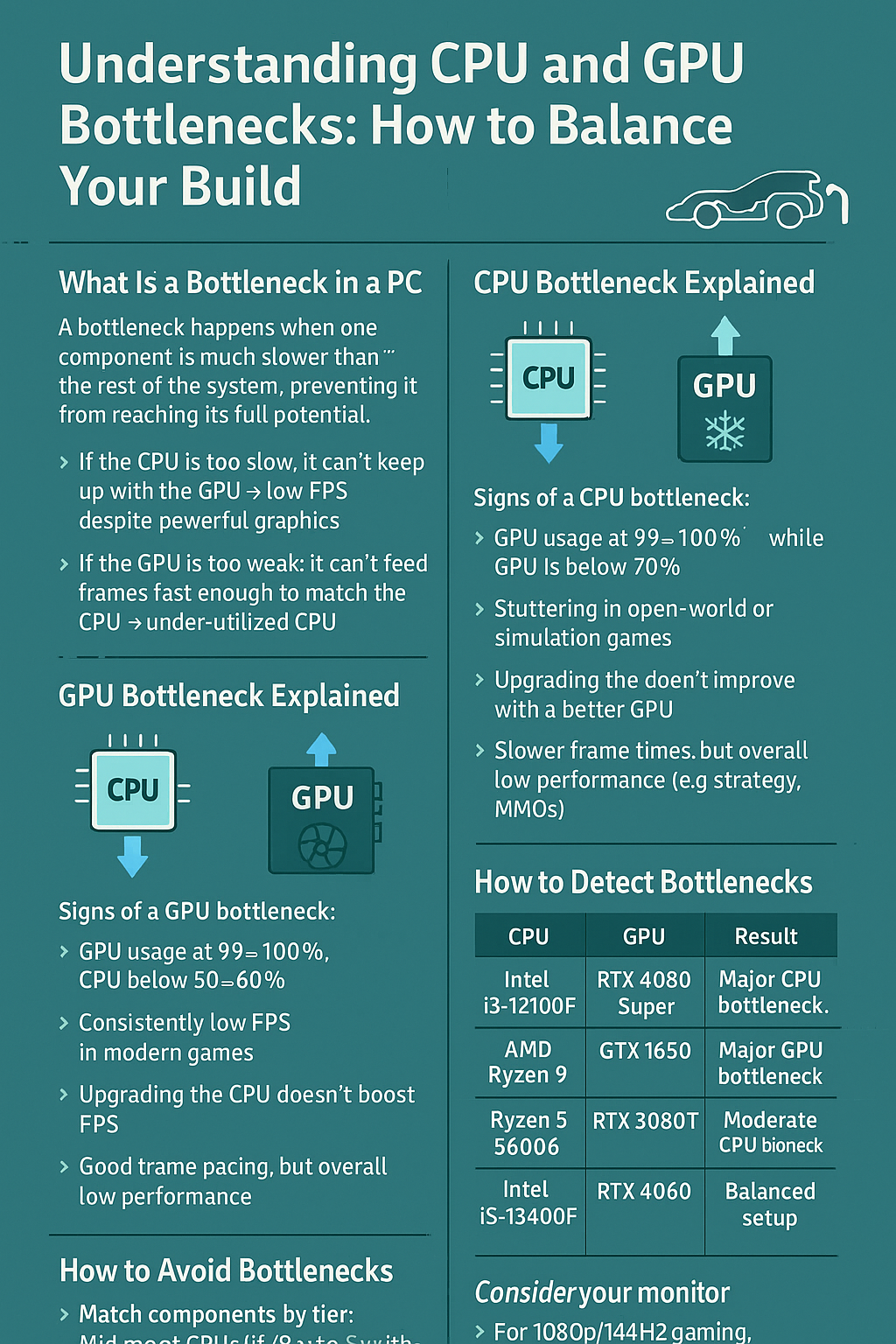One of the most frustrating issues for PC builders is a bottleneck — when one component limits the performance of another. The most common cases involve the CPU and GPU not working together efficiently, which leads to lost performance, stuttering, or wasted money.
In this article, we’ll explain what bottlenecks are, how to detect them, and how to build a balanced PC in 2025.
What Is a Bottleneck in a PC?
A bottleneck happens when one component is much slower than the rest of the system, preventing it from reaching its full potential.
- If the CPU is too slow, it can’t keep up with the GPU → low FPS despite powerful graphics
- If the GPU is too weak, it can’t feed frames fast enough to match the CPU → underutilized CPU
Think of it like a race car stuck in traffic — it doesn’t matter how fast it can go if something is holding it back.
CPU Bottleneck Explained
Occurs when the processor can’t process game logic, physics, or instructions fast enough to feed the GPU.
Signs of a CPU Bottleneck:
- High CPU usage (90–100%), while GPU is below 70%
- Stuttering in open-world or simulation games
- Performance doesn’t improve with a better GPU
- Slower frame times in CPU-heavy games (e.g., strategy, MMOs)
GPU Bottleneck Explained
Occurs when the graphics card can’t keep up with the CPU’s demands, especially in high-resolution or graphically intensive games.
Signs of a GPU Bottleneck:
- GPU usage at 99–100%, CPU below 50–60%
- Consistently low FPS in modern games
- Upgrading the CPU doesn’t boost FPS
- Good frame pacing, but overall low performance
How to Detect Bottlenecks
Use real-time monitoring tools:
| Tool | Use |
|---|---|
| MSI Afterburner | Track CPU/GPU usage in-game |
| HWiNFO64 | Full system monitoring |
| CapFrameX | Frame time and performance analysis |
| Task Manager (Windows 11) | Basic usage metrics |
Compare CPU and GPU usage while gaming. If one is maxed out and the other is underused, you may have a bottleneck.
Examples of Bottlenecked Builds (2025)
| CPU | GPU | Result |
|---|---|---|
| Intel i3-12100F | RTX 4080 Super | Major CPU bottleneck |
| AMD Ryzen 9 7950X | GTX 1650 | Major GPU bottleneck |
| Ryzen 5 5600G | RTX 3060 Ti | Moderate CPU bottleneck |
| Intel i5-13400F | RTX 4060 | Balanced setup |
How to Avoid Bottlenecks
🔹 Match Components by Tier:
- Pair mid-range CPUs (i5/Ryzen 5) with mid-range GPUs (RTX 4060, RX 7600)
- Use high-end CPUs (i7/Ryzen 7+) with RTX 4070 and above
- Don’t overspend on one part while cutting corners on the other
🔹 Consider Your Monitor:
- For 1080p/144Hz gaming, a stronger CPU is more important
- For 1440p/4K, GPU becomes the primary bottleneck
- At higher resolutions, the CPU has less impact
Should You Worry About Bottlenecks?
Some bottleneck is inevitable — no system uses all components perfectly all the time.
Aim for a 10–15% difference in usage between CPU and GPU under load. If you see:
- 99% GPU, 70–80% CPU = good
- 99% CPU, 40% GPU = problem
Use your budget efficiently, not just to avoid bottlenecks, but to get the most value and real-world performance.
Tools for Building a Balanced PC
- PCPartPicker.com – Estimates bottlenecks and compatibility
- UserBenchmark (cautiously) – Shows system balance (but not always accurate)
- Build guides and subreddit advice – Compare builds from others with your goals
Final Tips to Prevent Bottlenecks
✅ Choose matched components (same performance tier)
✅ Research game-specific performance (some are more CPU-bound)
✅ Upgrade your monitor if GPU is bottlenecked at low resolution
✅ Update your BIOS and drivers regularly
✅ Benchmark before and after hardware changes
Final Thoughts
Bottlenecks can be frustrating, but they’re also easy to manage with the right planning. By understanding the roles of your CPU and GPU — and how they work together — you can build a PC that delivers smooth, consistent performance for years to come.
Remember: balance is better than brute force when it comes to building your perfect PC.
